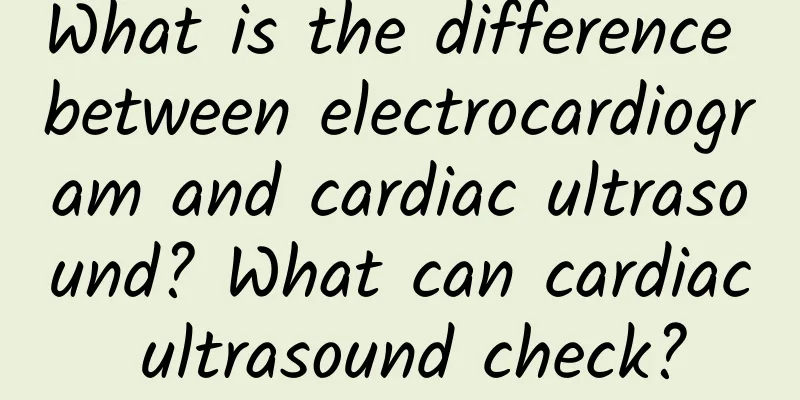What is the difference between electrocardiogram and cardiac ultrasound? What can cardiac ultrasound check?

|
Electrocardiogram and cardiac ultrasound are both examination methods of cardiology, and they are mainly used to check heart problems, such as coronary heart disease, arrhythmia, myocardial ischemia and other diseases. So what is the difference between electrocardiogram and cardiac ultrasound? What can cardiac ultrasound check? What is the difference between an electrocardiogram and a cardiac ultrasound?If the heart is compared to a house, then the electrocardiogram is to check for problems with the house's wiring, and cardiac ultrasound is to check for problems with the doors and windows. An electrocardiogram records the electrical activity of the heart and can detect problems such as arrhythmia, angina pectoris, myocardial infarction, atrial hypertrophy, ventricular hypertrophy, etc. Color Doppler ultrasound of the heart can dynamically observe and record the blood flow velocity of the heart, calculate the ejection fraction, and check whether there are any problems with the heart valves, whether the heart is enlarged, whether there is mitral stenosis or insufficiency, whether there is tricuspid stenosis or insufficiency, whether there is stenosis or insufficiency of the aortic valve and pulmonary valve, whether there is congenital heart disease, and whether there are problems such as atrial septal defect or ventricular septal defect. What can cardiac ultrasound check?Congenital heart diseaseCardiac color Doppler ultrasound can show almost all heart malformations, such as common septal defects, patent foramen ovale, outflow tract stenosis, tetralogy of Fallot, patent ductus arteriosus, etc. Cardiac color Doppler ultrasound can show unclosed defects and shunt blood flow, valvular stenosis or insufficiency, valvular malformation, etc. It is the preferred method for screening congenital heart disease. Acquired changes in cardiac structureIf it is not a congenital heart disease, but a change in the heart structure caused by acquired factors, it can still be observed through cardiac ultrasound. For example, we can see the changes in the heart structure, size, valves, thickness, etc., as well as the resulting changes in blood flow, and accurately measure the changes in the heart's atria, ventricles, valves, etc. Effective assessment of cardiac functionCardiac color ultrasound can intuitively show the heart's contractile function, ventricular wall motion analysis, coordination, etc., and can calculate ratios such as cardiac output per stroke, thereby effectively evaluating heart function, which cannot be replaced by other related examinations. To understand whether there are any abnormalities in the tissues adjacent to the heartThe presence or absence of pericardial effusion, pericardial calcification, the ascending and descending aorta, the superior and inferior vena cava, etc. are commonly used examination tools to understand the condition of the tissues adjacent to the heart. Evaluating the effectiveness of heart disease treatmentCardiac ultrasound can also be used to determine treatment direction, treatment method, treatment effect, etc. It is also an indispensable examination method for cardiologists. Common electrocardiogram examination methodsThe first one is the ordinary electrocardiogram (ECG) that everyone is most familiar with. ECG is relatively simple to operate and very fast, usually completing in 2-3 minutes. In most cases, it can make a clear diagnosis for patients with obvious arrhythmias and myocardial ischemia (which can be understood as a manifestation of coronary heart disease). In clinical practice, some patients' symptoms are not very obvious, such as intermittent arrhythmias, or myocardial ischemia in patients with mild coronary heart disease is not very obvious. In this case, ECG may miss the diagnosis and be biased. Fortunately, we still have a weapon, that is, Holter monitoring. Similar to dynamic blood pressure monitoring, Holter also needs to be worn on the body for 24 hours. The difference is that it is constantly performing heart monitoring that you cannot perceive. During this time, it will quietly record your heart rate, heart rhythm, and the blood supply and flow of the heart, and then conduct a more complete analysis through the doctor's interpretation. |
<<: Can diabetes be controlled without medication? Why do diabetics feel tired?
>>: Is arrhythmia dangerous? What are the dangers of sinus arrhythmia on electrocardiogram?
Recommend
How many months pregnant should I wear maternity pants
Pregnancy is also a difficult time for some mothe...
How long is the best time to have a painless abortion during pregnancy?
In life, many female friends get pregnant because...
Symptoms of nonspecific vaginitis
There are many types of vaginitis, and the names ...
If my high blood pressure is 150 and my low blood pressure is 95, do I need to take medicine? If I meet the conditions, I don't need to take medicine for the time being.
A friend of Huazi was diagnosed with high blood p...
Dressing for girls with thick calves
Although many girls have thick calves, it does no...
"Healthy eating" series | How to eat healthily in spring? Here are the secrets to "keeping healthy"
...
What to do if you have too much leucorrhea
Everyone's physical condition is different du...
Is vulvar leukoplakia contagious?
It is very common for women to suffer from vulvar...
What causes ectopic pregnancy?
There are many types of ectopic pregnancy, among ...
What is the reason for frequent appendage pain?
Female friends nowadays do not take care of their...
Postpartum Chinese medicine shampoo recipe
For many women, their bodies are actually quite w...
What to eat to get the thinnest belly for women
I believe that many people always find that their...
When do women usually have their periods?
In our daily life, we will have many feelings whe...
Is crying in the wind a disease?
Due to the recent snowfall, the temperature has d...









